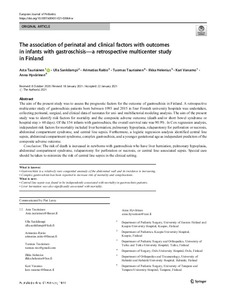The association of perinatal and clinical factors with outcomes in infants with gastroschisis-a retrospective multicenter study in Finland
Vanamo Kari; Raitio Arimatias; Helenius Ilkka; Tauriainen Tuomas; Hyvärinen Anna; Sankilampi Ulla; Tauriainen Asta
The association of perinatal and clinical factors with outcomes in infants with gastroschisis-a retrospective multicenter study in Finland
Vanamo Kari
Raitio Arimatias
Helenius Ilkka
Tauriainen Tuomas
Hyvärinen Anna
Sankilampi Ulla
Tauriainen Asta
SPRINGER
Julkaisun pysyvä osoite on:
https://urn.fi/URN:NBN:fi-fe2021042823957
https://urn.fi/URN:NBN:fi-fe2021042823957
Tiivistelmä
The aim of the present study was to assess the prognostic factors for the outcome of gastroschisis in Finland. A retrospective multicenter study of gastroschisis patients born between 1993 and 2015 in four Finnish university hospitals was undertaken, collecting perinatal, surgical, and clinical data of neonates for uni- and multifactorial modeling analysis. The aim of the present study was to identify risk factors for mortality and the composite adverse outcome (death and/or short bowel syndrome or hospital stay > 60 days). Of the 154 infants with gastroschisis, the overall survival rate was 90.9%. In Cox regression analysis, independent risk factors for mortality included liver herniation, pulmonary hypoplasia, relaparotomy for perforation or necrosis, abdominal compartment syndrome, and central line sepsis. Furthermore, a logistic regression analysis identified central line sepsis, abdominal compartment syndrome, complex gastroschisis, and a younger gestational age as independent predictors of the composite adverse outcome.
Conclusion: The risk of death is increased in newborns with gastroschisis who have liver herniation, pulmonary hypoplasia, abdominal compartment syndrome, relaparotomy for perforation or necrosis, or central line-associated sepsis. Special care should be taken to minimize the risk of central line sepsis in the clinical setting.
What is known:
- Gastroschisis is a relatively rare congenital anomaly of the abdominal wall and its incidence is increasing.
- Complex gastroschisis has been reported to increase risk of mortality and complications.
What is new:
- Central line sepsis was found to be independently associated with mortality in gastroschisis patients.
- Liver herniation was also significantly associated with mortality.
Kokoelmat
- Rinnakkaistallenteet [19250]
